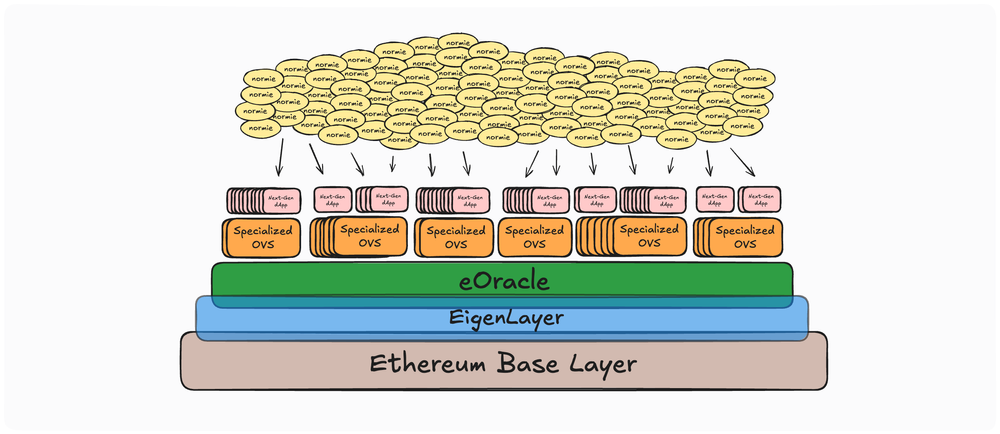Understanding Oracle Validated Services (OVS) Web2 Data Standard to Web3
Oracle Validated Services (OVS) represents a fundamental step toward making WEB3 THE NEW INTERNET. They’re a paradigm shift in how blockchain applications access real-world data.
This document explains the concept, its importance, and why it represents the natural evolution of blockchain oracle services.
SIMPLY EXPRESSED - Enjoy
The Current Oracle Landscape
Today's blockchain oracle services follow a "one-size-fits-all" approach:
- Attempt to supply various types of data (but in reality, support mostly price feeds)
- Limited validator networks (30-40 validators + - )
- Permissioned systems with centralized control points

The Web2 Data Model
In the traditional web space (Web2), data provision evolved naturally into specialized services:
- Sports data comes from sports experts (eg; Sportradar)
- Financial data comes from financial experts (eg: Yahoo Finance)
- Weather data comes from meteorological experts (eg; Weatherstack)
Each provider focuses on their core competency!!
No single website serves as "data.com" for all data types - instead, applications in need of data go to specialized providers who are experts in their field.

Introducing OVS: A Natural Evolution
OVS (Oracle Validated Services) bring Web2's data specialization to blockchain dApps through a clear four-layer architecture:
- Layer 1: Ethereum - The Foundation
- "The New Internet" base layer
- Provides fundamental blockchain security and decentralization
- Houses 1M+ potential validators
- Layer 2: Eigenlayer - The Bridge
- Connects Ethereum validators to eOracle
- Cryptoeconomic security through restaking
- Unifies validation & slashing across services
- Layer 3: eOracle - The Oracle Infrastructure
- Core infrastructure layer for all OVSs
- Manages validator connections
- Provides development framework and SDK for permissionless oracle creation
- Layer 4: OVSs - The Specialized Data & Computation Services
- Specialized oracle services (OVS 1, 2, 3, etc.), each focused on a specialized data/computation field:
Cyber OVS | Prediction OVS | Insurance OVS | eSports OVS, and more... - Built and operated by domain experts
- More aligned and customized for specific dApp needs
- Specialized oracle services (OVS 1, 2, 3, etc.), each focused on a specialized data/computation field:
Data Flow Through the Layers:
- Various Data is collected by specialized providers
- Providers connect to their relevant OVS
- OVSs process and validate data through eOracle infrastructure
- Eigenlayer coordinates validator participation
- Ethereum provides the security and decentralization foundation
- dApps consume validated data from relevant OVSs - winning all benefits
This four-layer architecture ensures:
- Clear separation of concerns
- Specialized expertise at the application layer
- Strong security foundation
- Scalable infrastructure
- Credibly-neutral market for specialized data and computation services
Each layer serves its specific purpose while working TOGETHER to create a comprehensive, secure, and specialized (data/computation<—>onchain) ecosystem.
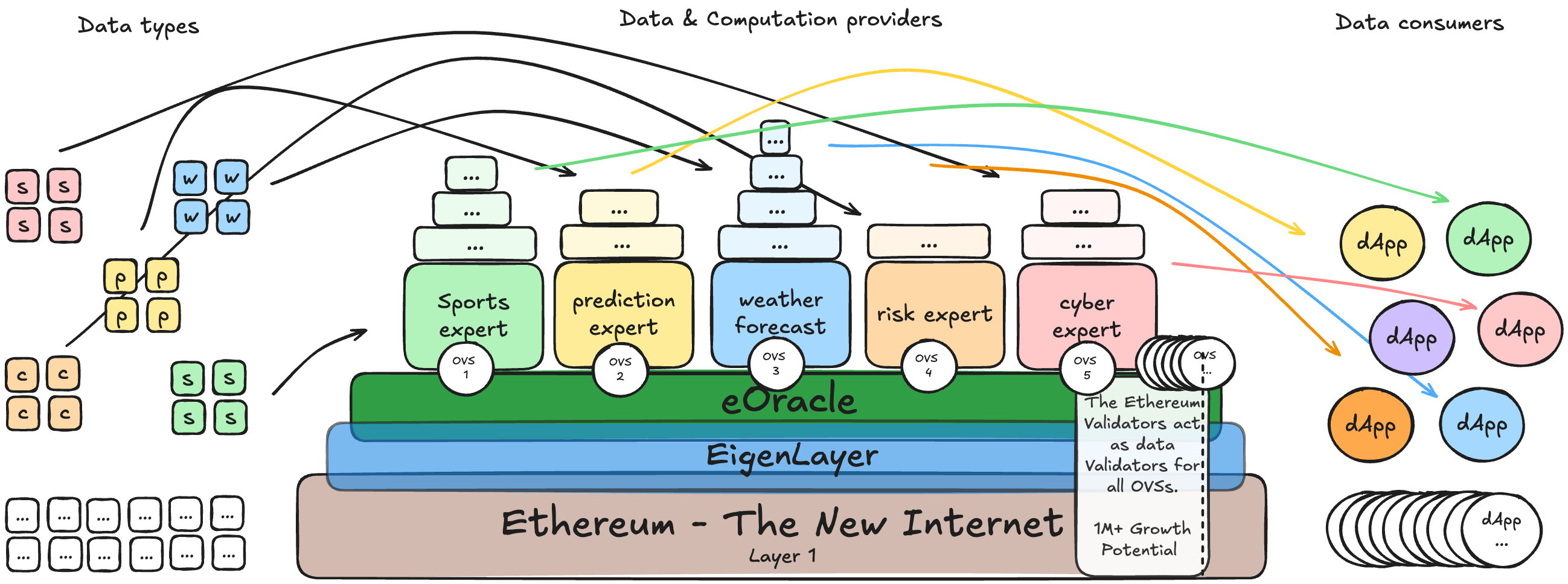
Benefits of the OVS Model - It’s SIMPLE.
For Builders Who Want To Provide Data & Computation in their Expertise.
- Lower barriers to entry:
- No need to bootstrap validator network (uses Ethereum validators through Eigenlayer)
- No need to build oracle infrastructure (uses eOracle)
- Can focus purely on building their specialized oracle product
- Reduced development time from years to weeks
- Significantly lower costs alongside significantly higher level of security
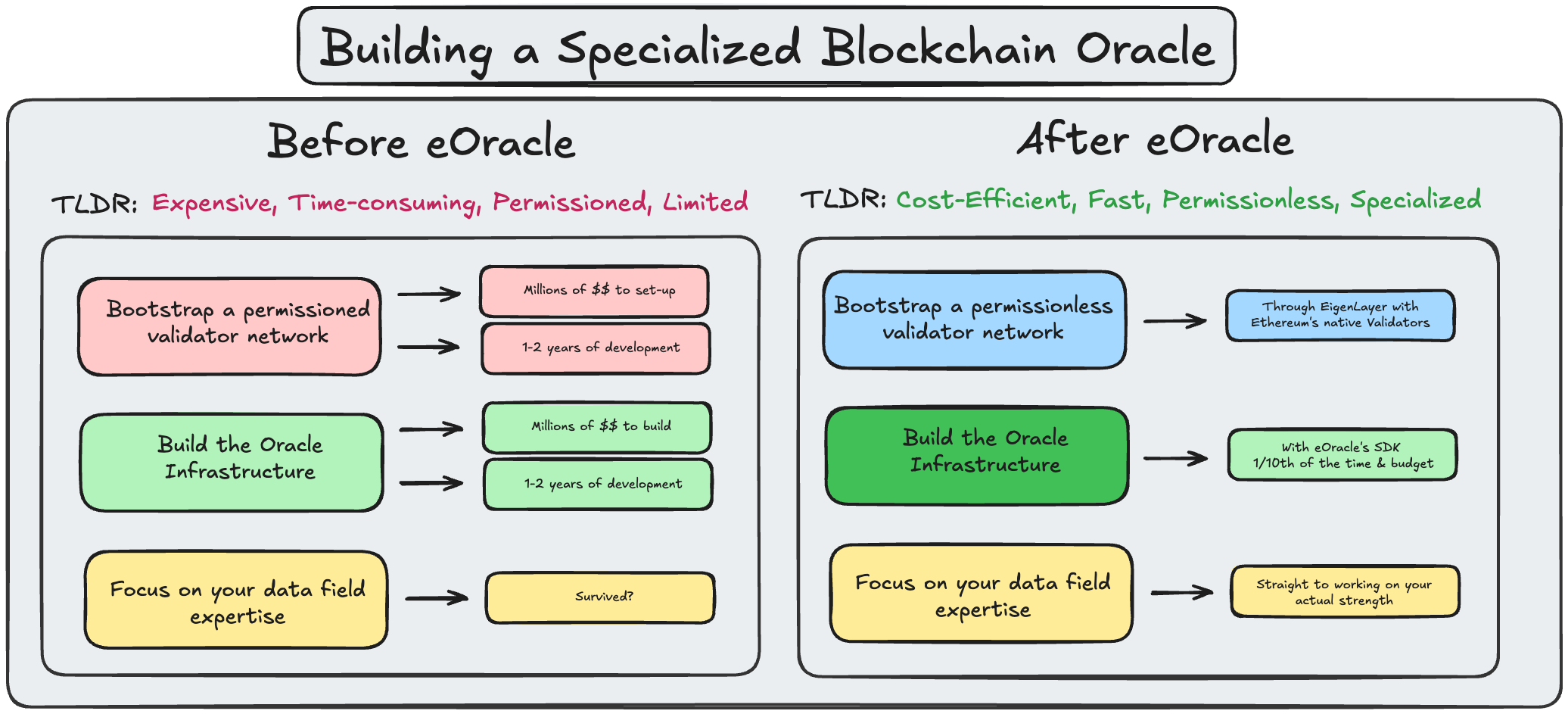
Real World Example: Hexagate - The Cyber Oracle
TLDR; one of the early specialized OVS built on eOracle is revolutionizing smart contract security through decentralized monitoring.
By leveraging eOracle's infrastructure, Hexagate is decentralizing its "Invariant Monitoring Engine," distributing computation among eOracle validators to monitor critical smart contract security in real time.
- Invariants are conditions that should always hold true within a protocol, such as "users cannot withdraw more than they deposit" or "the sum of user balances equals the total supply."
Hexagate's oracle continuously checks these conditions, providing an early warning system for potential vulnerabilities or attacks.
The incredible part here is that Hexagate is securing today some of the most used protocols in crypto, such as: Uniswap, AAVE, BASE, EigenLayer, GMX, Metamask and many more.
By building on eOracle, Hexagate achieves several key improvements:
- Reduced centralization risk and possibilities of false reports or censorship
- Enhanced reliability through distributed computation and consensus
- Increased transparency, with all checks and reports visible on the eOracle chain
This innovative use of oracle technology demonstrates one out of infinite ways in which builders can leverage OVS Infrastructure for Specialized solutions, and in this case —> how we approach protocol security, providing real-time, decentralized monitoring for critical blockchain infrastructure.

———
To learn more about Hexagate - The Cyber Oracle, click here.
———
Innovation Through Specialization - Enabling Next-Generation dApps
One of the most exciting aspects of the OVS model is its ability to enable entirely new categories of decentralized applications that were previously impossible. This is due to the diverse datasets and specialized computational expertise OVS provides.
- Specialized oracles can deliver complex, domain-specific computation and data that general oracles lack the expertise to provide.
- Deep domain expertise allows for sophisticated data processing and validation
The Innovation Cycle
The OVS model positive feedback loop:
Specialized oracles emerge —> New dApp possibilities appear —> Developers build novel applications —> Demand for specialized data increases —> More specialized oracles emerge
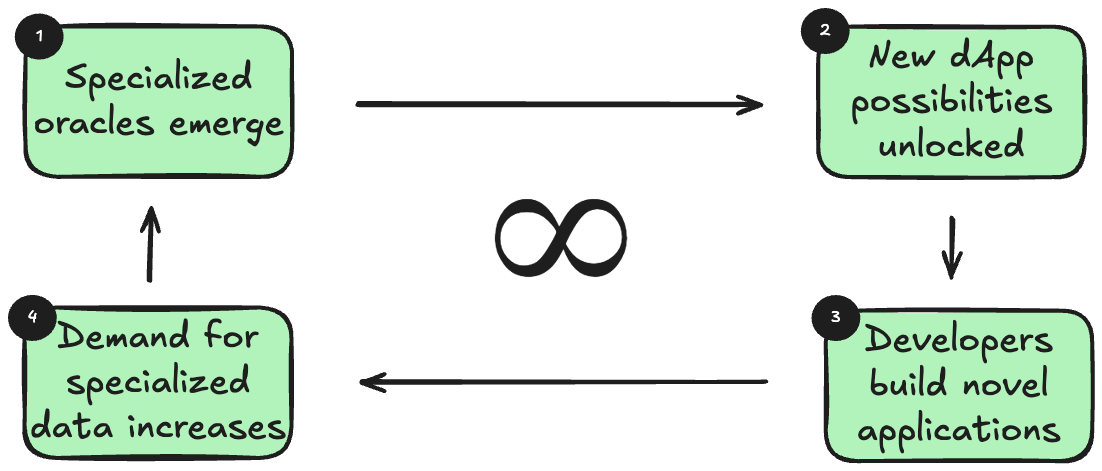
Who Needs a Search Engine When We Have Yellow Pages?" - Quote from the 90’s
Just as search engines created possibilities no one could envision in the 90's (fair.. there was almost nothing on the internet), OVSs are laying the groundwork for Web3's future:
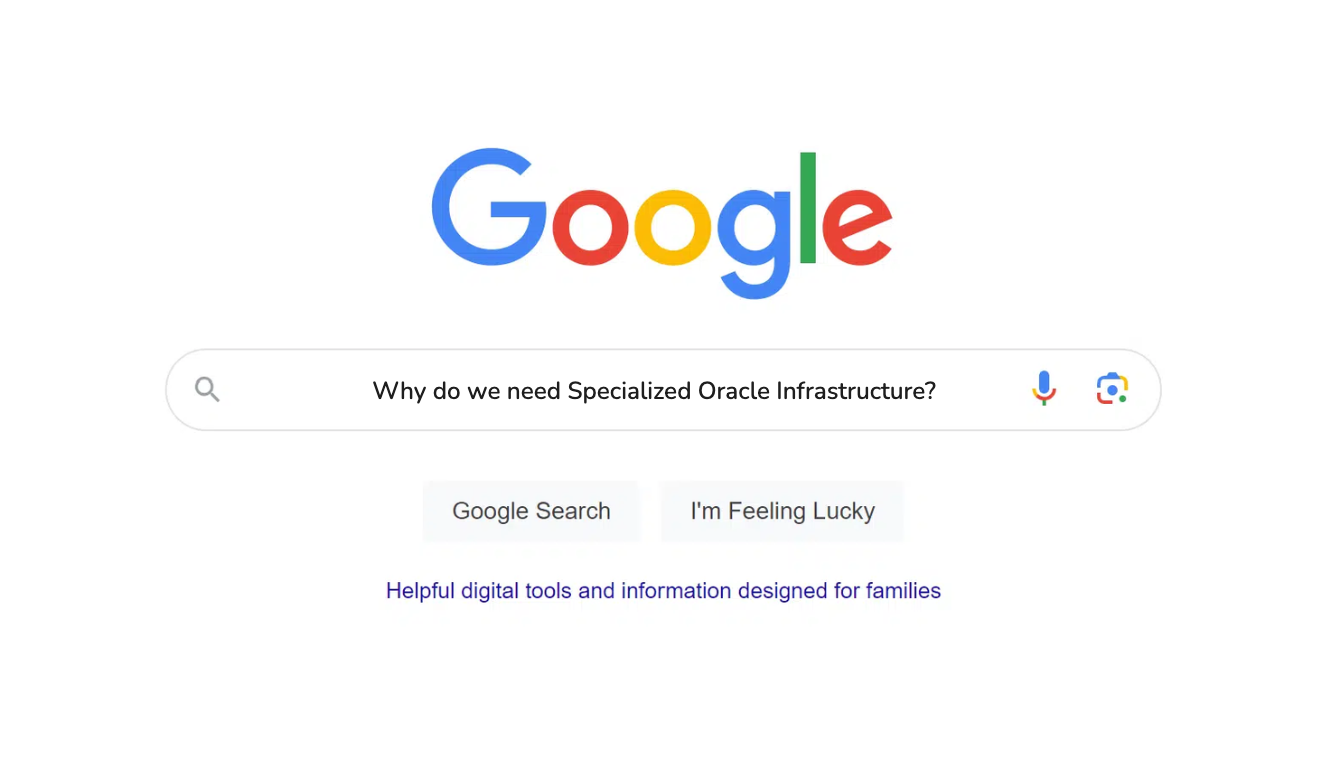
- Today: Basic price feeds
- Tomorrow: Specialized data & computation services
- Future: An interconnected Web3 ecosystem with unimaginable use cases
Similarly, as search engines were necessary for the internet to realize its full potential, Web3 requires specialized oracle infrastructure to unlock its true capabilities.
Normies underway - The Web3 Stack
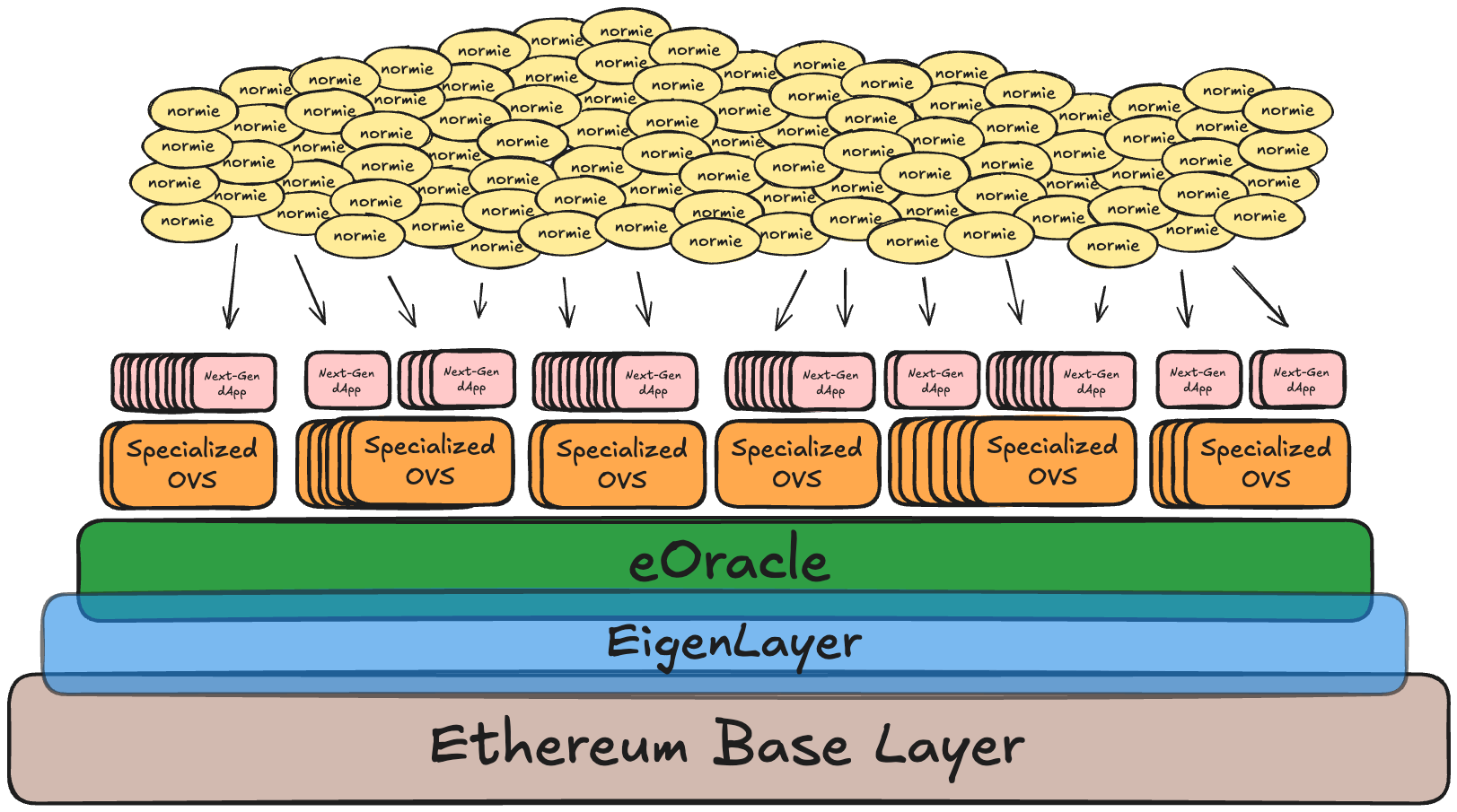
Conclusion
OVS represents a natural evolution from one-size-fits-all oracles to --> specialized Web3 data infrastructure, combining Web2's domain expertise with blockchain's decentralized security.
It isn't just about better data feeds—it's about unlocking an entirely new universe of Web3 applications that we can't even imagine yet.
As Layer 2s solved the 'how many' problem, specialized oracles will solve the 'what's possible' problem. The oracle revolution will be to application diversity what Layer 2s were to scalability.
Don't blink anon.


